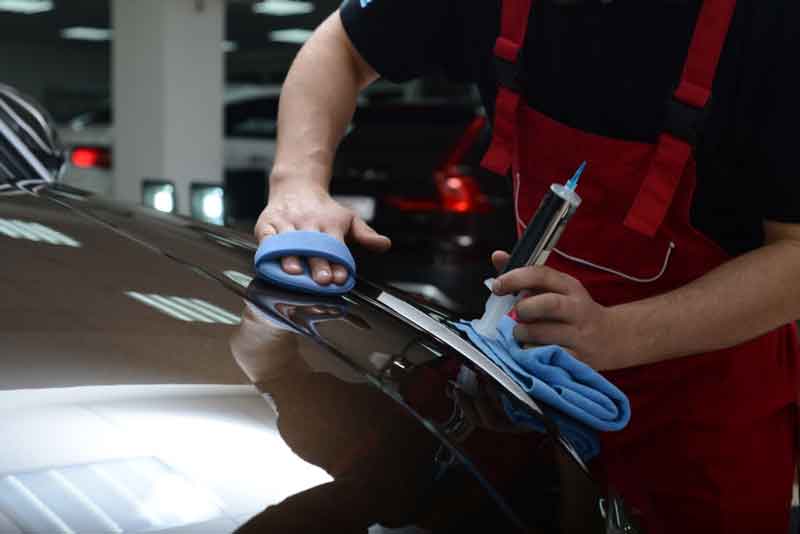Adding a layer of sealant to your car will protect it from different elements. Find out how easy it is to do it like a pro!
If you’re interested in keeping your car clean and spotless, you’re going to want to apply some form of protection to your gleaming paintwork. A sealant is a great option: It combines long-lasting protection, with a dose of added gloss. A good sealant will last longer than your conventional carnauba wax and is easier to apply too.
Consider sealant as the final step in a job well done, one which solidifies your attention to detail with a clean car. It ensures a level of protection from the elements, which includes resistance to UV damage fading paintwork, and acid rain or bird droppings from etching in.
As dirt adhesion is greatly reduced, you’ll find yourself having to wash your car less frequently too. Plus, washing your car will be easier, with less time spent drying, as water beads and shears off the paintwork easily after rinsing.
The benefits of using sealant are numerous. So, let’s see how you can do it properly.
How to Apply Sealant: The Hand Method
If you don't have access to a tool such as a dual-action polisher, fear not. Applying sealant is easy and doesn't require too much effort.
To start with, you need a clean car. It's best to apply a sealant to a car straight after a thorough wash. No dirt or dust must be on the paintwork before you start spreading the sealant, as this will cause hard-to-remove scratches and swirl marks.
To apply the sealant by hand you’ll need a good quality sealant (obviously, but many are available!), an applicator pad and a couple of microfiber towels.
Top Tip:
You’ll want to ensure that the vehicle that you’re applying the sealant to is parked out of the shade, and the body panels are cool to the touch. If not, you risk having the product burn up and harden too quickly. This makes it difficult to spread and even harder to remove without a streaky finish.
Apply a dime-sized amount of sealant to your applicator pad, and begin to work a panel at a time. The idea behind your method should be that you're attempting to apply an even coat to the entire panel. Therefore, less is more, as the excess sealant will just end up being wasted
You may find circular motions are natural. That action is by far the method most used by detailing professionals. But you may also find that this results in swirl marks if by chance your applicator pad picks up any dirt. To avoid this, we’d recommend using straight lines, back and forth, ensuring that you don’t miss any spots.
You can choose to either cover the entire car at this point or stop to buff the sealant off after each panel. Either way, you’re going to want to let the sealant cure for about 5-10 minutes. Depending on what brand of sealant you’re using, you may find the longer you leave the sealant sitting on the car, the harder it is to remove. This may not be a problem for you, but it's worth bearing in mind.
When it comes to buffing, you’re going to need a clean and soft microfiber towel. Fold it in quarters, and use a similar back-and-forth action to gently remove the cured sealant. Remember to keep turning the towel as the sealant residue builds up on the cloth, and switch to a second towel if you feel the need to.
And that’s it: a shinier and protected car! It wasn’t that difficult, now was it?
Advanced: Using a Dual Action Polisher
You can save time and effort in the process of applying sealant by using a dual action polisher. It also makes it far easier to apply an even coat of sealant to the paintwork of your car.
The method is largely the same when using a dual action polisher to applying sealant by hand (as above). But there are a few things to bear in mind.
The dual action polisher replaces the need to use a hand applicator pad, but you’ll still need a sealant or wax applicator pad for the polisher.
When starting, apply a few dots of sealant to the pad of the dual action polisher. You can then lightly dab this on the areas you intend to cover before starting on the panel. This is so that the dual action polisher will pick up a little bit extra sealant as you go along.
Remember, you’re not polishing the car, but you’re merely spreading the sealant. With this in mind, you want to apply little-to-no pressure on the body as you’re using the polisher. You’ll also want to use one of the slower settings, so as not to cause too much heat buildup.
Once everything is covered, you can proceed to buff the sealant off as you would normally.
How Often Should I do it?
There's no hard-and-fast rule to how often you should apply a sealant to the exterior of your vehicle. It depends on multiple factors, including what brand of sealant you've used, how often you wash the car, and what kind of environmental factors or weather is the car being used in.
Most brands advertise a life of anywhere between three and twelve months but take note of how well water beads to your car's surface, and how glossy it appears to make your own judgement of when to reapply.
